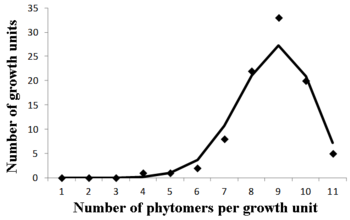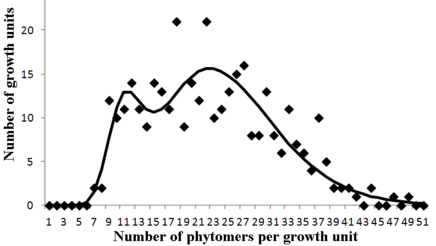Applications
Fitting
Plant structure fitting- Rhythmic development examples
Examples of rhythmic growth.
-
The following examples concern pre-formed growth units on the beech tree and bimodal distributions on the poplar.
On this first example, 8 classes of growth unit size were considered.
Their respective number of phytomers and frequencies are given below:
| Number of growth units | 0, | 1, | 1, | 2, | 8, | 22, | 33, | 20, | 5 |
| Number of phytomers | 3, | 4, | 5, | 6, | 7, | 8, | 9, | 10, | 11 |
A single binomial fitting (see "../../P3_Tools/Tool_breg_001.html ) leads to :
N = 11 and b = 0.79

Pre-formed growth units on the beech tree (Graph P. de Reffye, CIRAD)
-
Ten classes of growth unit sizes are considered.
The curve stands for the fitted binomial law: N = 11, b = 0.79
The second example illustrates the growth unit size distribution on poplar tree branches (physiological age 2).

Growth units on the poplar tree (Graph P. de Reffye, CIRAD)
-
A classic bimodal distribution observed on poplar branches.
The curve stands for the following five parameters
- Binomial law parameters for the pre-formed part B(12,0.68 )
- Negative binomial law parameters for the neo-formed part Bn(5 , 0.76)
- the proportion of neo-formation, pn = 0.86.
